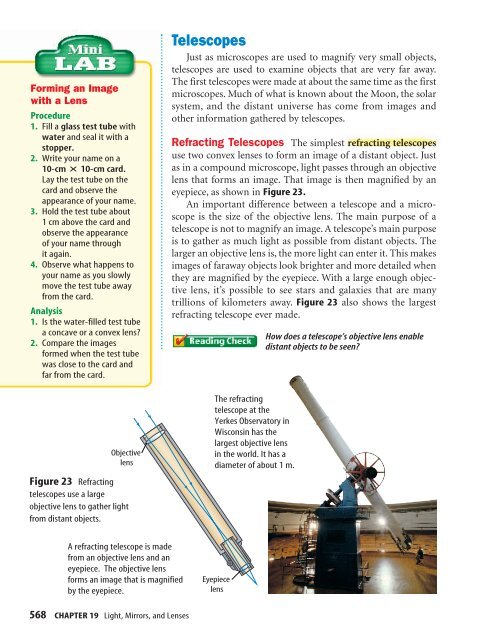Light Mirrors and Lenses (3379.0K) - McGraw-Hill Higher Education
Light Mirrors and Lenses (3379.0K) - McGraw-Hill Higher Education
Light Mirrors and Lenses (3379.0K) - McGraw-Hill Higher Education
- No tags were found...
Create successful ePaper yourself
Turn your PDF publications into a flip-book with our unique Google optimized e-Paper software.
Forming an Imagewith a LensProcedure1. Fill a glass test tube withwater <strong>and</strong> seal it with astopper.2. Write your name on a10-cm 10-cm card.Lay the test tube on thecard <strong>and</strong> observe theappearance of your name.3. Hold the test tube about1 cm above the card <strong>and</strong>observe the appearanceof your name throughit again.4. Observe what happens toyour name as you slowlymove the test tube awayfrom the card.Analysis1. Is the water-filled test tubea concave or a convex lens?2. Compare the imagesformed when the test tubewas close to the card <strong>and</strong>far from the card.ObjectivelensTelescopesJust as microscopes are used to magnify very small objects,telescopes are used to examine objects that are very far away.The first telescopes were made at about the same time as the firstmicroscopes. Much of what is known about the Moon, the solarsystem, <strong>and</strong> the distant universe has come from images <strong>and</strong>other information gathered by telescopes.Refracting Telescopes The simplest refracting telescopesuse two convex lenses to form an image of a distant object. Justas in a compound microscope, light passes through an objectivelens that forms an image. That image is then magnified by aneyepiece, as shown in Figure 23.An important difference between a telescope <strong>and</strong> a microscopeis the size of the objective lens. The main purpose of atelescope is not to magnify an image. A telescope’s main purposeis to gather as much light as possible from distant objects. Thelarger an objective lens is, the more light can enter it. This makesimages of faraway objects look brighter <strong>and</strong> more detailed whenthey are magnified by the eyepiece. With a large enough objectivelens, it’s possible to see stars <strong>and</strong> galaxies that are manytrillions of kilometers away. Figure 23 also shows the largestrefracting telescope ever made.The refractingtelescope at theYerkes Observatory inWisconsin has thelargest objective lensin the world. It has adiameter of about 1 m.How does a telescope’s objective lens enabledistant objects to be seen?Figure 23 Refractingtelescopes use a largeobjective lens to gather lightfrom distant objects.A refracting telescope is madefrom an objective lens <strong>and</strong> aneyepiece. The objective lensforms an image that is magnifiedby the eyepiece.Eyepiecelens568 CHAPTER 19 <strong>Light</strong>, <strong>Mirrors</strong>, <strong>and</strong> <strong>Lenses</strong>S0

















